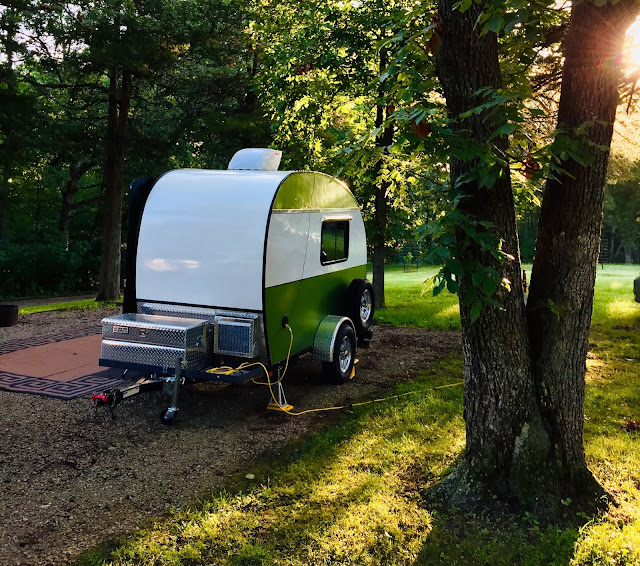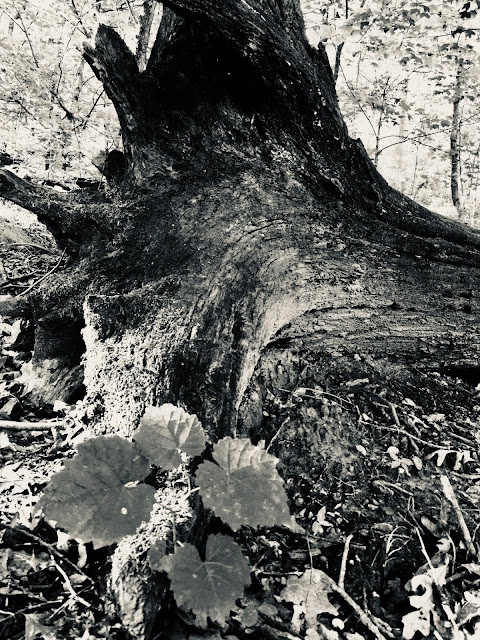Bears in the Wild
The best beginning for this adventure is the end, when tiny trailer traveler Mary Larson wrote, "I was thinking about the stats from this trip, and it got pretty fun to come up with one very long (but I’m pretty sure not a run-on) sentence that summarizes it all.
Traveling 5,511 miles over
18 days with
1 dog and
1 cat through
2 countries (which included visits to
10 US states and
6 Canadian provinces), and spending the night at
1 amazing boondocking site,
1 Harvest Host site,
1 community park campground,
1 KOA, and not sleeping well in
1 ferry reclining chair, but sleeping a whole lot better in
2 WalMart parking lots, including a combined total of
10 nights at
5 wonderful mom and pop campgrounds, plus taking
3 ferries and seeing, among other things,
50+ icebergs
10+ moose and
2 lynx, while buying
4 new tires and
far more tankfuls of fuel than I care to think about, all while making
countless memories has added up to
1 epic adventure.
Yes, that ending sentence is the perfect lead for this travelogue of her epic, school-is-out trip from Virginia to the Maritime Provinces in Canada.
 |
| Chewy gets his first look at Canada. |
Of all the possible trips Mary could take, why did she choose the Maritimes? "In all honesty, I’m a transplant to Central Virginia from the Upper Midwest, and I hate the beastly hot summers here. I always either head to the Blue Ridge or I head north. I’ve been to Ontario, Quebec, and Nova Scotia (one of my favorite places on the planet) but had never done it in my camper." The big draw for this particular trip was to head to Newfoundland to see icebergs. "Everything else was just a wonderful part of a wonderful journey."
Mary states she is "a bit of a nerd by nature, so I’m quite a researcher when it comes to planning trips. I start researching new areas months in advance." In the case of this Maritimes trip, she started researching and planning more than six months before leaving. "I am an introvert, I hate crowds, and I always prefer to take those roads less traveled. The Grizzly [her tiny trailer] is perfect for all of these things."
Segment One: Days 1-4
Three "pretty hard driving days" characterized the beginning of Mary's trip as she traveled from Virginia to Grand Falls, New Brunswick, Canada, with "not much time to stop and take photos." Places traveled through were ones familiar from the past, so she was "okay that I didn't stop to see and do things." Instead, Mary "just stuck to I-81 and the Trans Canada Highway to try to get there faster."
 |
| "But . . . I woke up to a bright and beautiful morning. I spent the night at a Harvest Hosts site--Rohrbach's Farm Market, Bakery and Barn Loft. It was a wonderful place to spend a quick overnight. My parking companions that night were a big rig RV and a Scamp, but they both left in the morning before I could snap a photo of the three of us looking like a misfit trio together." |
 |
| Chewy (in carry bag) and Huck. "This is Chewy's first hiking adventure and my first attempt to hike with the two of them." |
The first camping stop for Mary--and her dog and cat--was at Grand Falls, which she felt was "worth every bit of those three days of driving. What a beautiful place!"
Segment Two: Days 5-7
A day of rest at Grand Falls segued into another marathon drive of ten hours through Nova Scotia to Sydney, in order to "catch the ferry across to Newfoundland--the main destination of this year's trip."
 |
| "Obviously, all we did was drive today. Zoomed through NS and didn't have time to snap a pic until we were crossing into Cape Breton. I plan to take this part of the trip a bit more slowly on the way home." |
One would expect to lose some sleep and be fatigued from a long day, especially a ten-hour day to make the ferry to Newfoundland, but then the ferry crossing would be restful and a time for sleep, right? Wrong! "The seats were designed for taller people than me, and I just couldn't get it quite right. It turns out I'm not the only one--the lady here at the campground is short, and she said the same thing. She decided that men designed them and forgot about short women--I think she's right!"
 |
| "Our ship awaits. There were two loading ramps--the upper one which you can see and the lower one which you can see a bus entering at the far right side. The ferry was very nice. We set sail from Sydney, NS, at 11:45 P.M. and arrived in Port aux Basques, NL, at 7:15 A.M. I didn't sleep well, but the good news is that I didn't get seasick. That was probably my biggest fear about this entire trip. And . . . it was so rough when we got into Newfoundland that one of the ladies who worked at the terminal said she was surprised we even crossed. Now they tell me . . . LOL." |
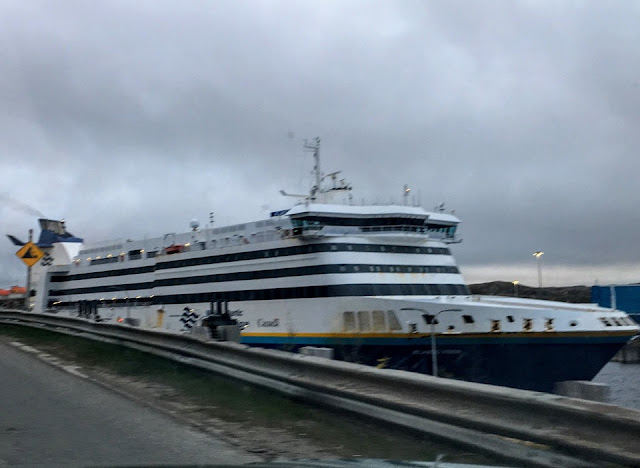 |
| "Here is our ship the next morning . . . waiting to head back to Nova Scotia." |
Mary finally got in a bit of traveling after catching up on sleep, and a full day of exploring the southwest coast of Newfoundland the next day.
"I ate my first real Newfoundland local meal today at lunch--cod au gratin--and it was delicious. I passed on the fried cod tongues today, but I will likely give them a try before I head home. Tomorrow we head north again to a place called Cow Head, which is in Gros Morne National Park and about halfway up the western shore of Newfoundland. We won't be up to 'iceberg country' until later in the week, but I'm sure we will see lots of beautiful things along the way. I haven't seen any moose on Newfoundland yet--only the ones in New Brunswick so far--which is a good thing. As the locals say--best that they stay in the woods and not jumping out in front of your car."
 |
| "My delicious lunch from the Seashore Restaurant in Fox Roost today . . . Cod au Gratin. It was delicious. Cod is the main fish here, and I look forward to eating it in all sorts of ways while I am here. I may even try fried cod tongues--just wondering how many codfish tongues it takes to make a meal, though. I'll keep you posted." |
 |
| "This is the view from very close to the campground. Mountains shrouded in clouds and still lots of spots with snow. There are some glaciers in these mountains, but they are not accessible by car." |
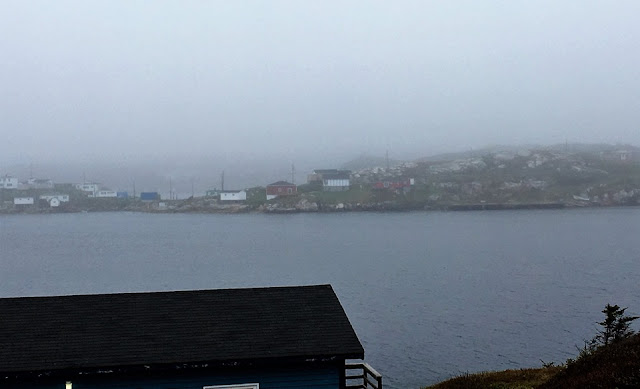 |
| "On Sunday morning, I headed out as far as I could go along the south coast of Newfoundland. It was very foggy, as the coast tends to be. This is the little fishing village of Rose Blanche, and it is, literally, at the end of the road. In fact, my GPS didn't even register the road I was traveling on." |
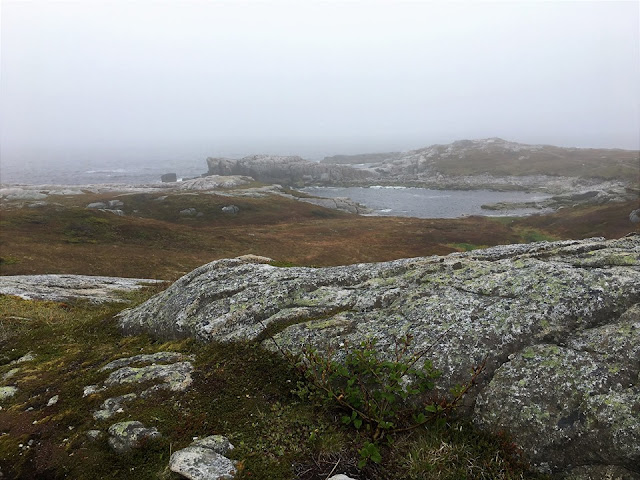 |
| "I couldn't get out to the Granite Lighthouse, as a lot of the attractions are not yet open in June, as the schools tend to get out at the end of June, and that's when they get their touristy crowds. But . . . I could look at some pretty seashore in the fog." |
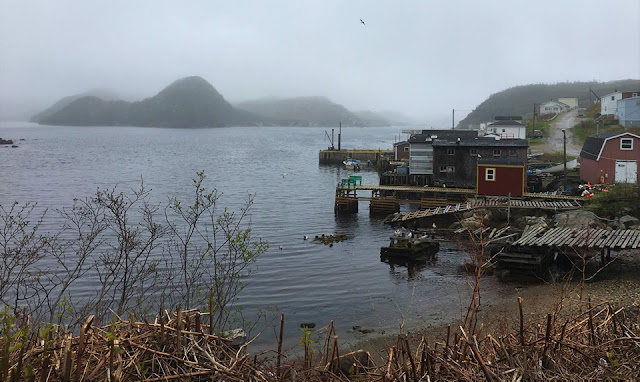 |
| "The sign at this little spot said Little Cove, though it wasn't on the map." |
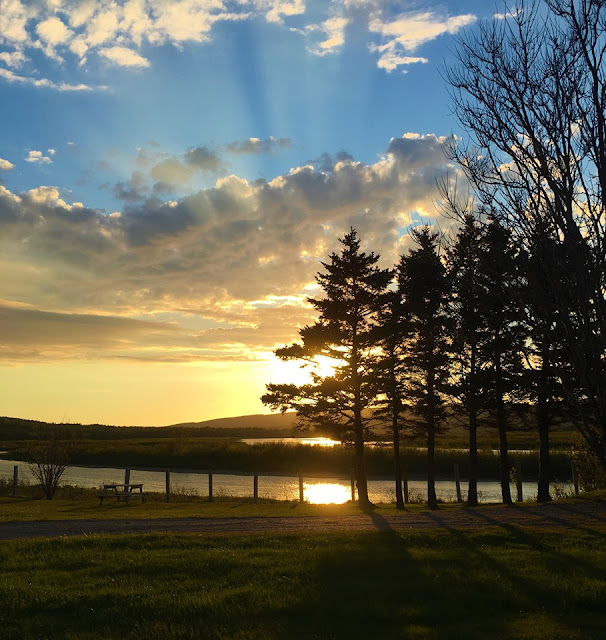 |
| "The sun starting to set . . . it was getting windy and cool once the sun started going down. But . . . blue skies and sunshine . . . at 9:30 at night. One of the beauties of being at the higher latitudes this time of year. A wonderful way to end a beautiful day." |
Segment 3: Days 8-9
On June 19, Mary, Chewy, and Huck headed out for the final leg of their Maritimes adventure before turning south and heading home. Leaving the southwest coast of Newfoundland, Mary had no idea what to expect and was surprised at how the area looked, saying, "It actually reminded me a bit of Montana and the US West as we got closer and closer to our destination for the next two days."
 |
| "Our first glimpse of Gros Morne NP." |
"I don't know about y'all, but I had never heard of Gros Morne National Park until I started planning this trip. It happened to be on the way to our destination at the tip of the Northern Peninsula, so I figured we would explore it a bit to see what it had to offer, but I really hadn't done my research at all."
 |
| "We headed out to the Tablelands to hike and passed through the community of Woody Cove on the shore of one of the fjords." |
Chewy, the "king of the camper," got to stay home as Mary and Huck took off. "He and Huck needed a break from one another. It was a good decision for all," Mary said. The day didn't look too promising at first, "but as we got to the higher elevations in the park, the sky started to clear and the views were breathtaking."
"Gros Morne is one of the most beautiful places I have ever visited in my life. It is absolutely breathtaking--from the fjords to the Tablelands to the moose and the lynx and everything in between. I fell in love with this place in an instant. All of this natural beauty and best of all . . . no crowds."
The Tablelands reminded Mary of hiking in Arizona--but without the snakes. The terrain looked like it has been excavated in many places, but it was actually the earth's mantle exposed with nothing but barren red rock.
Arriving at
Sea Breeze B&B and RV Park, Cow Head, Gros Morne National Park, Newfoundland, Mary and her pals started to get settled in for the night. She had been ready to take in the beauty of her surroundings but found herself additionally surprised by an unexpected and happy occurrence--she met some fellow teardroppers.
The next day, they packed up and headed north up the Viking Trail (Hwy 430 up to the northern tip) to Quirpon--smack dab in the middle of Iceberg Alley, where they spent the next three days before heading south to catch the ferry and start their trip home.
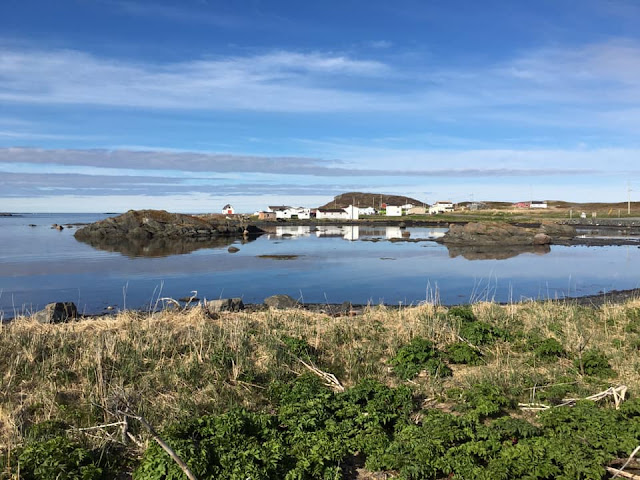 |
| L’Anse aux Meadows on Quirpon Island where Mary stayed. |
Segment 4: Destination--Icebergs, Days 10-11
On the tenth and eleventh days of her trip (and a half of day twelve), Mary traveled to the northern tip of Newfoundland's Northern Peninsula, the St. Anthony and L'anse aux Meadows area of Quirpon Island in search of icebergs. "This was the main thing that I wanted to see on this trip. As I rolled over 2,500 miles on Day 10, heading north from Cow Head and Gros Morne (and still had not yet hit the main event), I was saying to myself, "This had better be worth it."
"It was," Mary says. "Absolutely, positively worth every mile, every pothole, every liter of fuel, and every moment of playing referee to two equally stubborn pets living together in a very small space for long days in the car and tight quarters in the camper. I’ve always enjoyed my travels over the years, but this one is right up there at the top alongside the trip to Scotland several years ago."
 |
| "This iceberg looked like a schooner sailing into the Harbor, and it took my breath away every single time I saw it. The size and the majesty of this particular iceberg were incredible. I’m sure the top of it was well over 50 feet high. When you were driving down the road that paralleled it, you could see the top peeking over the tops of the high bluffs, and they’re pretty tall." |
The locals told Mary that the first two days that she was there were the best weather days they had had so far in the season. Day 3 of this time brought more typical weather. In her travels, Mary discovered that "even the ‘busy’ places are not even remotely crowded compared to what we’re used to at home, and it is super easy for a hermit like me to spend hours without encountering another human if that’s what you enjoy."
Mary's good camera stopped working so she drafted her cellphone "to try to convey the grandeur and the scale of icebergs," realizing her cell camera was "barely a mediocre second," to record her last "days at the tippy top of Newfoundland."
Besides hunting icebergs, Mary also learned a bit about (aboot?) the life of the residents of Newfoundland. It's a life closer to earth and bare bones rock, one that still uses sun to dry clothes, a life that tills soil and plants gardens, one that uses wood-burning stoves to keep warm on cold winter nights.
a |
| "This is in the town of Saint Carol. One of the things that I noticed very quickly when I got out into the smaller settlements was the number of what remind me of Amish clotheslines. I only took this one picture because she had the prettiest pink and purple things out there, but that day there were lots and lots of clothes and sheets and you name it flapping in the breeze." |
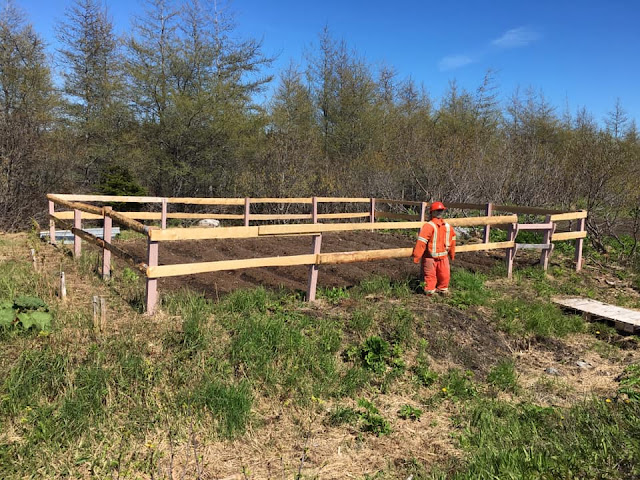 |
| "Another thing that was very interesting to me where the roadside gardens. As you look at some of the other photos you can see there’s nothing but rock in so many of these places, and there’s just no place for someone to have a garden at home. Apparently, when they built the highways, they brought in good soil and the best soil is along the side of the roads. So . . . there are lots of these little roadside gardens. This one had my favorite scarecrow. They are actually to keep the moose and not the birds away." |
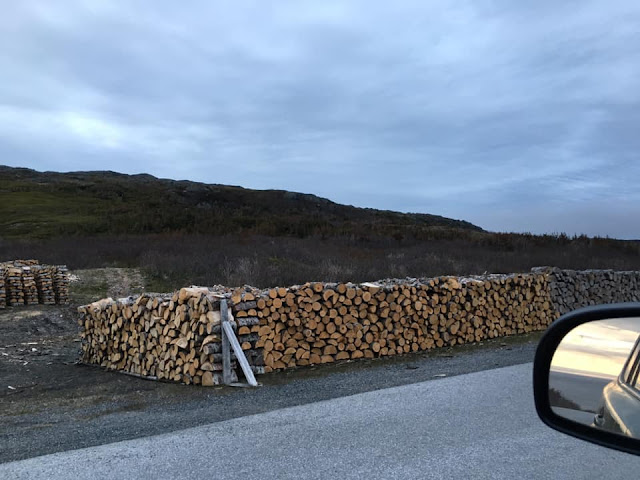 |
| "The further north I got, the more common these roadside stacks of wood would be. They were as common as the gardens were. These are individual people's firewood that they’re stacking in preparation for the winter. Again, because of the rocky and uneven terrain, as well as the fact that they tend to have very small yards but need lots and lots of wood to heat all winter long, they don’t store it at home. Everyone knows who the woodpiles belong to, and nobody bothers anyone else’s." |
Mary's adventures extended even to her campground arrival. "I always meet the most fun and interesting people when I travel . . . and this trip has been no exception. Tonight is my first night at a campground at the northern tip of Newfoundland. When I pulled into the park, I saw one side of this teardrop and was blown away. I decided to ask the folks if they would let me take a photo and we got to talking . . . turns out, they have been full timing in their teardrop for the past four years. In that period of time, they have hit the 49 US states that can be driven to (meaning no Hawaii) and, as of this week, every single Canadian province. Newfoundland was the last one on their list. In the morning, they are headed home and closing out one heckuva adventure."
"So here comes the 'there are no coincidences' part," Mary adds. "What are the odds that of all the campgrounds in all of North America I would not only meet these people on the very last day of their trip . . . but would also learn that the very first sticker that they put on their teardrop . . . was from a camping trip to Virginia? Chincoteague was the start of their adventure. They also have a 'Virginia is for Lovers' sticker and an Assateague one from the same trip. And now . . . after four years on the road . . . they are going home. Anyway . . . I just thought that this little encounter was very, very cool. Hope you do, too!"
Segment 5: The Trip Home, Days 12-18
Half a day was spent sight-seeing on Day 12, but Mary finally opted to begin heading home because the weather was so bad, eliminating a long, 400-mile single-day drive to catch the ferry. The roads were awful in the rain, and Mary and her teardrop rig were escorted down the road almost exclusively by big trucks and RVs, most locals keeping close to home. "The first day, I got as far as Gros Morne National Park. The second day, still in the driving rain, I made it down to the campground where I stayed when I had first arrived on the island."
As it turned out, there was no rush because the ferry had not run for two days due to the winds. The 11:45 P.M. ferry was finally scheduled to run again, but Mary asked to be rebooked for the next morning, mostly because the sea looked rough, and she didn’t feel like a long ferry ride with motion sickness. "Plus, there were probably folks who were booked on the other three canceled crossings who thought they would be home by now and who needed to get back to work."
 |
| Arches Provincial Park |
When Mary stopped at Arches Provincial Park, having missed it on the way up, she met two women, quite a bit older than Mary, who had just come across on the Trans Labrador Highway. Mary had looked into it when planning her trip, but because of the condition of the road and the potential for damage to her car and trailer, it didn’t seem prudent.
"These two were like the devil and the angel on your shoulder. The more sensible one was telling me about all the damage that they had experienced on their brand new RV and kayak trailer (there was a lot of damage), as well as the very steep and scary 17% grades, the over 200 km of gravel road and big potholes in Labrador, and just all of the general pitfalls. She wasn’t being negative. She was just being realistic. Her partner was the ‘Mary’ of the two of them--the eternal optimist. She would just wave her hands when the other one was telling me about the things to worry about, as if to say, ‘Don’t let her discourage you . . . you need to do this trip!’ She had pulled out the maps and was showing me the route and telling me that it wasn’t that bad and to ‘just do it . . . you only live once!’ If I didn’t have a nearly brand new trailer and if I had a car with greater ground clearance than my Outback, it would have been tempting. But . . . I had done a lot of reading about the TLH when planning this trip, and the recommendation is that you travel with two spare tires, an air compressor, a satellite phone, and the expectation that your vehicle will be damaged. I’d like to go it someday, but not this year."
 |
| "Now you can see why they can’t grow gardens at home!" |
 |
| "Norris Point in Gros Morne NP--loving all of the waterfalls after the rain." |
As luck would have it, when Mary asked to change her ferry departure time, the agents "were thrilled to have someone who didn’t want to cram under the same ferry as the rest of the people from the previous four sailings, and they actually allowed me to make my change with no change fee." The campers and cars were loaded below while the big trucks were loaded a deck or so above where Mary was located.
As Mary loaded, she enjoyed seeing a fellow teardrop traveling couple, the husband having built the teardrop. "The wife was adorable and told me that she would show me the inside, but it was packed full of things. I told her that I certainly understood because mine was the same way."
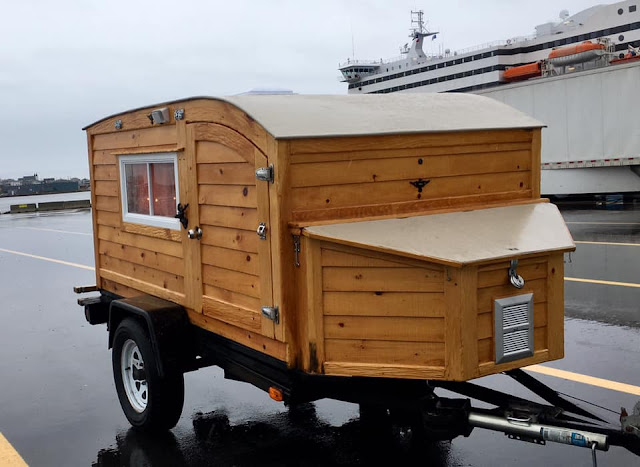 |
| "This darling camper was in line right behind me. It is one of the tiniest campers I have ever seen." |
Mary reserved a sleeping berth because she knew she wanted to get a good rest while sailing, and she did indeed sleep through most of the "pretty smooth" crossing. "I was very pleased with the cabins. For $45 extra, it was money well spent."
Mary disembarked around 6:30 P.M., and having lots of energy and about three hours of daylight left, she headed over to the Gaelic College (Colaisde na Gàidhlig) in St. Ann’s, on the Cabot Trail. The college is a non-profit that is dedicated to preserving and promoting the culture of the Scottish Highlanders who settled on Cape Breton. To her surprise the gift shop was open, so she was able to buy something she really wanted, a
bodhrán, a type of Gaelic drum.
Her trip to Cape Breton could have been complete at that point, but Mary still needed to find a place to stay the night. "It was only about 7:30, so I had a few good hours of daylight left. (I didn’t have reservations for the remaining nights of my trip, so I was playing it by ear on the way home. I actually prefer to travel this way and have had some of my best trips that way.) I hadn’t planned to do it, but since I was already on Cabot Trail, I decided to check it out. As I was getting close to the top of the Cabot Trail, I remembered a place called Meat Cove, which is at the tippy top of Cape Breton that was supposed to have a campground with great views. The GPS said that I could make it there before 10 P.M., so I decided that I would camp there for the night. Thirty minutes and some winding gravel roads later, I still wasn’t there, but came to a pull off where an RV was pulled over for the night and there was room for me, too. The sun had set, but there was still a bit of a glow in the sky. It was time to call it a night.
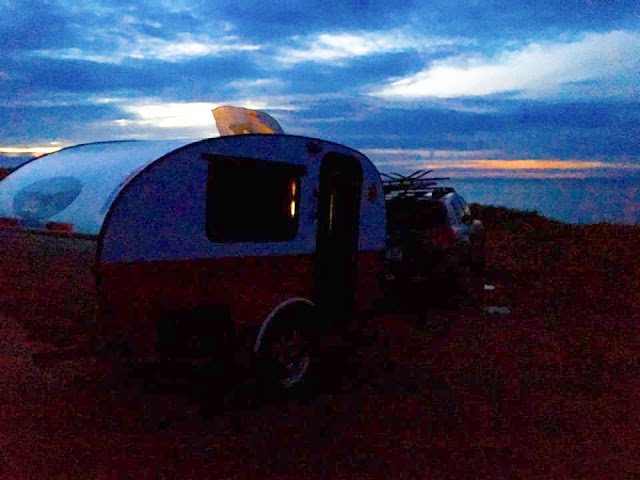 |
| "This is one more spot where I ventured off the beaten path." Roadside stop for the night, north and beyond the Cabot Trail. |
Waking up to a beautiful dawn (the campsite on a north point had both beautiful sunrise and sunsets), Mary headed off to the ferry to PEI, arriving at the ferry a little before noon. After driving through three provinces in fourteen hours (and a ferry ride), the day ended at a campsite in New Brunswick within sight of the Confederation Bridge. "It was one of the most beautiful days we have had on the entire trip."
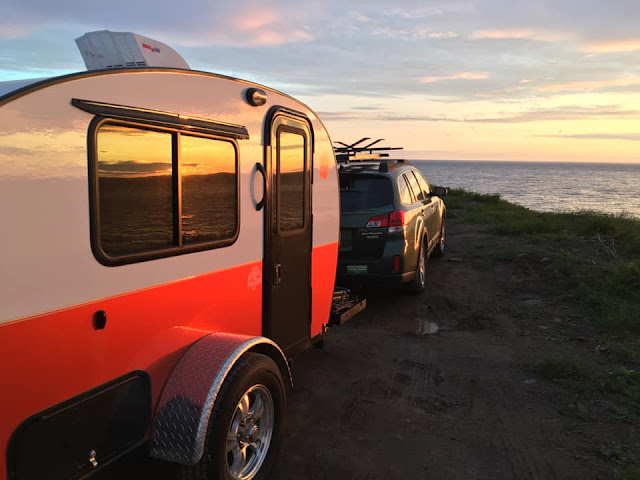 |
| Sunrise on a point near Meat Cove |
 |
| "As it turns out, my bluff top campsite was way better than the Meat Cove Campground." |
 |
| Cabot Trail view |
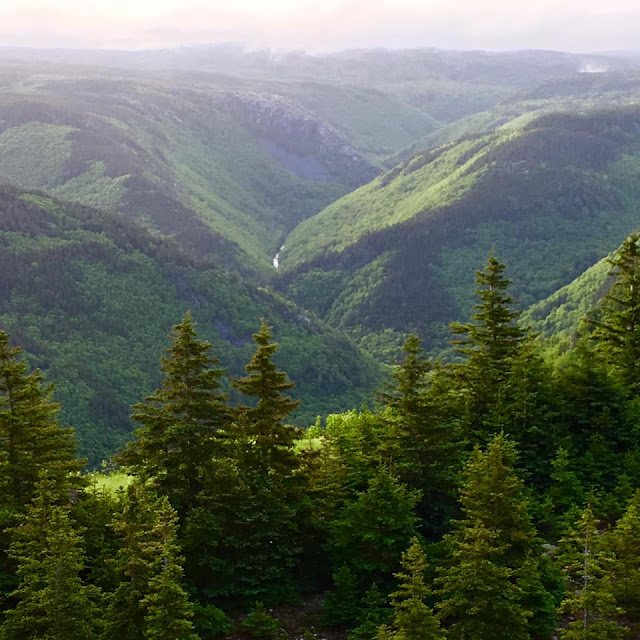 |
| Cabot Trail view |
 |
| "An iconic PEI lighthouse. My camper is becoming the Forrest Gump [of tiny trailers] and photobombing all sorts of places." |
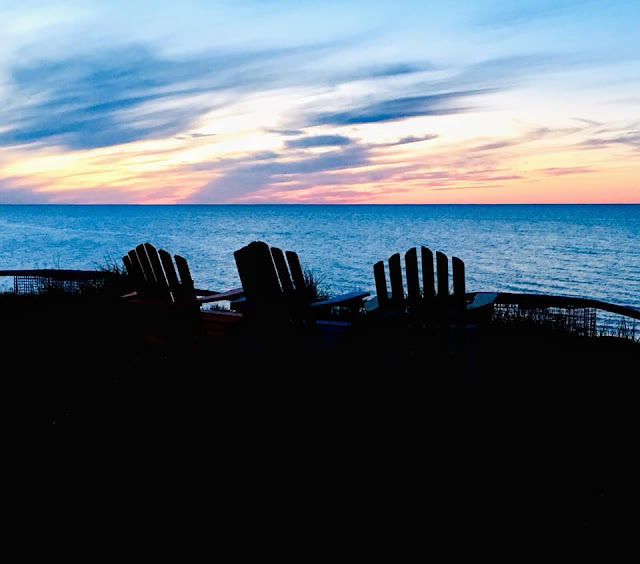 |
| Celebrating 4,000 miles for this trip, Mary spent the night in New Brunswick at a campground near the Confederation Bridge, which connects PEI with NB. (Silver Sands Family Campground) |
As the trip home continued, the weather worsened, and the photos were few and far between. It was "too crummy most of the seventeenth day to even stop to take a photo." The final days home ended up being lots of miles, a few photos, and new tires as the intrepid travelers started to close in on the last thousand miles of the journey.
 |
| WalMart overnighter. |
"I booked it to Maine in the pouring rain," Mary said, "and it was during that time that I realized just how very bad my tires were. I decided that I would camp at Walmart that night and get new tires in the morning. I have camped at many a Walmart in my travels, and there will typically be anywhere from zero to six or eight campers. I think eight were the most campers that I had seen at a Walmart overnight before this particular night."
When Mary pulled into the parking lot, there were five other campers. As the night progressed, that number increased. There were camping units of every shape and size, converted school buses, camper vans, people in the back of pickup trucks with tents, big rig RVs, pop up campers, pickup truck slide-in campers. "You name it. The early birds got the good spots." By morning, Mary counted more than twenty different camping units. "I don’t know about anyone else, but that’s a new Walmart record for me. There were young people, old people, single people, families, couples, dogs. And even my cat."

Enjoying the luxury of her own"private waiting room," Mary refereed her two traveling companions rivalry. "While the rest of the people waiting for their tire service sat in the little waiting room with the old magazines and the loud TV, we hung out in the camper. This is how we wait for tires to be put on the car. Please note the pillow standing on end by the window. I had to put that up between them so they didn’t look at each other and harass one another. It’s been like traveling with two little kids who want to poke and bother each other the entire trip. They tolerate one another at home, but cooped up in small spaces brings out less than the best in shared-space behaviors. The pillow did help because they couldn’t stare at one another. I’ve used these pillows quite frequently for that purpose on this trip."
"New tires and free and easy down the road we go," was Mary's travel song. Finally, after a last day of fifteen and a half hours of driving and over seven hundred miles, at 1:33 A.M.--arrival! And thus ends Mary Larson's excellent adventure on roads less traveled, having planned her destinations away from the tourist traps. "I spent my days finding my way to the smallest little outposts on the island, knowing full well that the same icebergs that folks were flocking to see, elbow to elbow with the tour bus crowds, could be seen from the bluffs overlooking the same waters and that my dog, Huck, and I would have these locations all to ourselves."
Mary ends by saying that a large part of any trip is research and planning, "but there is also always a lot of hitting the backroads once I get to my waypoints and destinations just to see what I can find or see or do." On this trip, Mary hit that sweet spot between over-planning and "leaping before you look." Her narrative and photos lead to a single, irrefutable conclusion: Planning on taking a trip? Wondering how to do it? Book on down the road like Mary, Huck, and Chewy--and you'll do just fine.
 A few weekends ago we took a Sunday drive to the campground to see what it looked like. Last year the park was closed for repairs and upgrades to the campsites. We were afraid the campground had been "modernized" like some--with a bulldozer to create the tract home, "Sewer Alley" look. Thank goodness that hadn't happened. Sewer had been upgraded, and a few more sites had been added to that area of the campground. On the non-sewer side, some tent sites had been converted to electric, and some of the old electric sites had been modified as pull-through sites rather than back-in. These modifications hadn't changed the feel of the campground, though.
A few weekends ago we took a Sunday drive to the campground to see what it looked like. Last year the park was closed for repairs and upgrades to the campsites. We were afraid the campground had been "modernized" like some--with a bulldozer to create the tract home, "Sewer Alley" look. Thank goodness that hadn't happened. Sewer had been upgraded, and a few more sites had been added to that area of the campground. On the non-sewer side, some tent sites had been converted to electric, and some of the old electric sites had been modified as pull-through sites rather than back-in. These modifications hadn't changed the feel of the campground, though.
